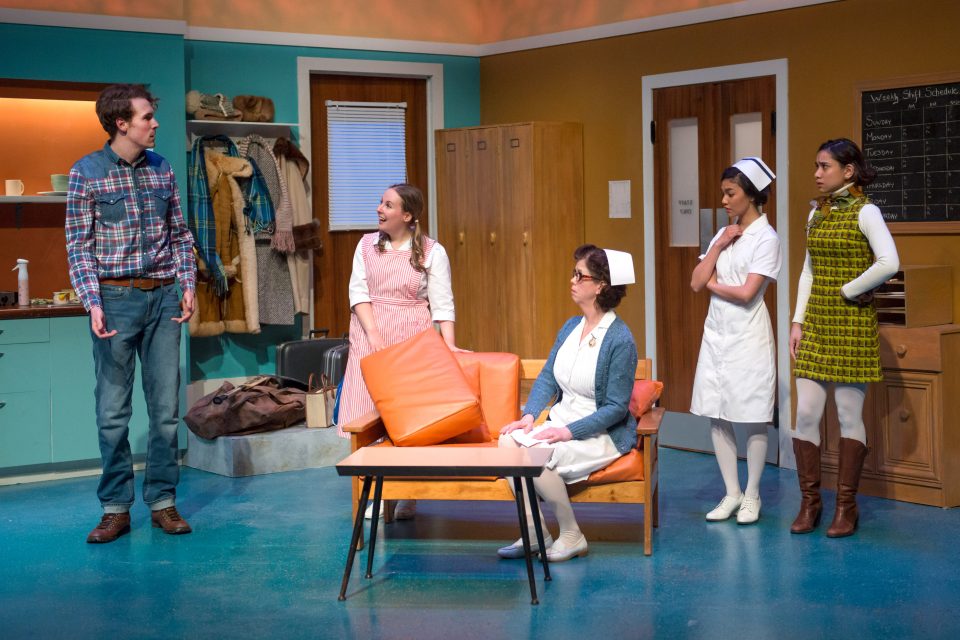Prairie Nurse: Funny moments but a problematic plot.

1000 Islands Playhouse in Gananoque, ON. Prairie Nurse, the latest show in TIP’s summer 2018 lineup produced in association with Toronto’s Factory Theatre, is billed as a “culture-clashing comedy” centering around the arrival of two Filipina nurses in a small Saskatchewan community in the 1960s. The play, written by Filipina-Canadian playwright Marie Beath Badian, certainly has its moments of humour and clever poking at Western assumptions of Asians; and this production, directed by Sue Miner, succeeds in effectively playing up these moments for audience reaction.
When it comes to the central plot, of a hospital lab technician falling in love with one of the nurses and courting both due to not being able to tell them apart however, it is less original. Both in its depiction of the romance and the characters concerned, Prairie Nurse regrettably relies on old stereotypes surrounding White-Asian relations.
The play starts off with senior nurse Marie Anne Lussier (Catherine Fitch) and young candy-striper Patsy Hackett (Janelle Hanna) preparing for the nurses’ arrival in the staffroom of the hospital near Arborfield, SK. With a large banner proclaiming “Mabuhay Nurses” (the Filipino word for welcome) and Filipino music playing in the background, the all-outness of the women’s efforts instantly gives off a comedic air. When the two nurses, Penny (Isabel Kanaan) and Puring (Belinda Corpuz) finally do arrive, cultural misunderstandings already abound; a sobbing Puring expresses her distress at having seen the town sign referring to Arborfield as the land of rape and honey, not knowing that the former refers to the crop. This misunderstanding is treated light-heartedly by the other characters, as are most such instances throughout the rest of the play. The romance portion of the show only begins when the goofy technician, Wilf Klassen (Matthew Shaw) falls in love with Puring at first sight after she’s fainted. Unable to tell her and Penny apart, he then ends up pursuing both to temporarily disastrous consequences.
The clichéd nature of the romance, as well as the unsympathetic traits of two of the involved characters, is where it falters the most. Not only is Wilf unable to tell the women apart, he is also revealed to already be engaged when he calls his fiancé back in his hometown and lies to her that he must stay and work at the hospital for the weekend (the real reason being that he can pursue Puring/Penny). While Puring is a genuinely sweet and humble character as portrayed by Corpuz, the other woman whom Wilf mistakenly pursues is exaggeratedly haughty. Set up to be a foil to Puring, Penny’s disdainful attitude towards Arborfield and her poorer compatriot simply smacks of the rich girl stereotype applied to an Asian character (though Kanaan gives her best effort in this regard).
The other characters are more realistically drawn. The long-suffering and irritated Marie and over-cheery Patsy, as portrayed by Fitch and Hanna, make for a comically relatable duo as Patsy’s schemes often come up against Marie’s orderliness. Mark Crawford is delightful as the hunting-happy Scottish doctor, Miles MacGreggor, while Layne Coleman provides a warm, grandfatherly presence as the hospital caretaker Charlie (who also acts as a protector for Penny and Puring).
The set and costume design by Jung-Hye Kim and Anna Treusch respectively also help to give the production a sense of realism. The hospital staffroom has the characteristic colours and older furniture reminiscent of the 1960s, while costumes are period appropriate and tailored to each character (the white nurse dresses and sailor-like hats are particularly notable).
While Prairie Nurse does contain some insightful commentary on our perceptions of those who are different from us, it’s a shame that these insights are mainly used for comic fodder.
Prairie Nurse continues until September 15 at the Springer Theatre in the 1000 Islands Playhouse. For information and tickets, see http://www.1000islandsplayhouse.com/prairie-nurse/